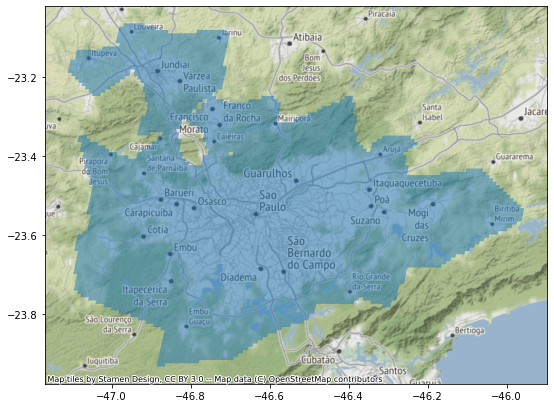GHSL
Contents
GHSL¶
Extract GHSL population for Sao Paulo (Brazil)¶
import geopandas
import rioxarray
import contextily
import datashader as ds
import matplotlib.pyplot as plt
Functional Urban Area boundary¶
The file with all the FUAs is available at:
url = ("https://jeodpp.jrc.ec.europa.eu/ftp/"\
"jrc-opendata/GHSL/"\
"GHS_FUA_UCDB2015_GLOBE_R2019A/V1-0/"\
"GHS_FUA_UCDB2015_GLOBE_R2019A_54009_1K_V1_0.zip"
)
url
'https://jeodpp.jrc.ec.europa.eu/ftp/jrc-opendata/GHSL/GHS_FUA_UCDB2015_GLOBE_R2019A/V1-0/GHS_FUA_UCDB2015_GLOBE_R2019A_54009_1K_V1_0.zip'
From there we can build a path to read and uncompress directly on-the-fly in geopandas:
p = f"zip+{url}!GHS_FUA_UCDB2015_GLOBE_R2019A_54009_1K_V1_0.gpkg"
fuas = geopandas.read_file(p)
sao_paulo = fuas.query("eFUA_name == 'São Paulo'").to_crs("EPSG:4326")
ax = sao_paulo.plot(alpha=0.5, figsize=(9, 9))
contextily.add_basemap(ax, crs=sao_paulo.crs);

Population layer¶
The file for the tile we need is available for download at:
url = ("https://cidportal.jrc.ec.europa.eu/ftp/"\
"jrc-opendata/GHSL/GHS_POP_MT_GLOBE_R2019A/"\
"GHS_POP_E2015_GLOBE_R2019A_54009_250/V1-0/"\
"tiles/"\
"GHS_POP_E2015_GLOBE_R2019A_54009_250_V1_0_13_11.zip"
)
url
'https://cidportal.jrc.ec.europa.eu/ftp/jrc-opendata/GHSL/GHS_POP_MT_GLOBE_R2019A/GHS_POP_E2015_GLOBE_R2019A_54009_250/V1-0/tiles/GHS_POP_E2015_GLOBE_R2019A_54009_250_V1_0_13_11.zip'
From there we can build a path to read and uncompress directly on-the-fly in xarray:
%%time
p = f"zip+{url}!GHS_POP_E2015_GLOBE_R2019A_54009_250_V1_0_13_11.tif"
ghsl = rioxarray.open_rasterio(p)
ghsl
CPU times: user 40.6 ms, sys: 3.2 ms, total: 43.8 ms
Wall time: 4.56 s
<xarray.DataArray (band: 1, y: 4000, x: 4000)>
[16000000 values with dtype=float32]
Coordinates:
* band (band) int64 1
* y (y) float64 -2e+06 -2e+06 -2.001e+06 ... -3e+06 -3e+06
* x (x) float64 -5.041e+06 -5.041e+06 ... -4.041e+06 -4.041e+06
spatial_ref int64 0
Attributes:
_FillValue: -200.0
scale_factor: 1.0
add_offset: 0.0
grid_mapping: spatial_refxarray.DataArray
- band: 1
- y: 4000
- x: 4000
- ...
[16000000 values with dtype=float32]
- band(band)int641
array([1])
- y(y)float64-2e+06 -2e+06 ... -3e+06 -3e+06
array([-2000125., -2000375., -2000625., ..., -2999375., -2999625., -2999875.])
- x(x)float64-5.041e+06 ... -4.041e+06
array([-5040875., -5040625., -5040375., ..., -4041625., -4041375., -4041125.])
- spatial_ref()int640
- crs_wkt :
- PROJCRS["World_Mollweide",BASEGEOGCRS["WGS 84",DATUM["World Geodetic System 1984",ELLIPSOID["WGS 84",6378137,298.257223563,LENGTHUNIT["metre",1]],ID["EPSG",6326]],PRIMEM["Greenwich",0,ANGLEUNIT["Degree",0.0174532925199433]]],CONVERSION["unnamed",METHOD["Mollweide"],PARAMETER["Longitude of natural origin",0,ANGLEUNIT["Degree",0.0174532925199433],ID["EPSG",8802]],PARAMETER["False easting",0,LENGTHUNIT["metre",1],ID["EPSG",8806]],PARAMETER["False northing",0,LENGTHUNIT["metre",1],ID["EPSG",8807]]],CS[Cartesian,2],AXIS["easting",east,ORDER[1],LENGTHUNIT["metre",1,ID["EPSG",9001]]],AXIS["northing",north,ORDER[2],LENGTHUNIT["metre",1,ID["EPSG",9001]]]]
- spatial_ref :
- PROJCRS["World_Mollweide",BASEGEOGCRS["WGS 84",DATUM["World Geodetic System 1984",ELLIPSOID["WGS 84",6378137,298.257223563,LENGTHUNIT["metre",1]],ID["EPSG",6326]],PRIMEM["Greenwich",0,ANGLEUNIT["Degree",0.0174532925199433]]],CONVERSION["unnamed",METHOD["Mollweide"],PARAMETER["Longitude of natural origin",0,ANGLEUNIT["Degree",0.0174532925199433],ID["EPSG",8802]],PARAMETER["False easting",0,LENGTHUNIT["metre",1],ID["EPSG",8806]],PARAMETER["False northing",0,LENGTHUNIT["metre",1],ID["EPSG",8807]]],CS[Cartesian,2],AXIS["easting",east,ORDER[1],LENGTHUNIT["metre",1,ID["EPSG",9001]]],AXIS["northing",north,ORDER[2],LENGTHUNIT["metre",1,ID["EPSG",9001]]]]
- GeoTransform :
- -5041000.0 250.0 0.0 -2000000.0 0.0 -250.0
array(0)
- _FillValue :
- -200.0
- scale_factor :
- 1.0
- add_offset :
- 0.0
- grid_mapping :
- spatial_ref
cvs = ds.Canvas(plot_width=600, plot_height=600)
agg = cvs.raster(ghsl.where(ghsl>0).sel(band=1))
f, ax = plt.subplots(1, figsize=(9, 7))
agg.plot.imshow(ax=ax, alpha=0.5, cmap="cividis_r")
contextily.add_basemap(
ax,
crs=ghsl.rio.crs,
zorder=-1,
source=contextily.providers.CartoDB.Voyager
)

Extraction¶
To clip what we need from ghsl based on sao_paulo, we can clip it:
ghsl_sp = ghsl.rio.clip(sao_paulo.to_crs(ghsl.rio.crs).geometry.iloc[0])
ghsl_sp
<xarray.DataArray (band: 1, y: 416, x: 468)>
array([[[-200., -200., -200., ..., -200., -200., -200.],
[-200., -200., -200., ..., -200., -200., -200.],
[-200., -200., -200., ..., -200., -200., -200.],
...,
[-200., -200., -200., ..., -200., -200., -200.],
[-200., -200., -200., ..., -200., -200., -200.],
[-200., -200., -200., ..., -200., -200., -200.]]], dtype=float32)
Coordinates:
* band (band) int64 1
* y (y) float64 -2.822e+06 -2.822e+06 ... -2.926e+06 -2.926e+06
* x (x) float64 -4.482e+06 -4.482e+06 ... -4.365e+06 -4.365e+06
spatial_ref int64 0
Attributes:
scale_factor: 1.0
add_offset: 0.0
grid_mapping: spatial_ref
_FillValue: -200.0xarray.DataArray
- band: 1
- y: 416
- x: 468
- -200.0 -200.0 -200.0 -200.0 -200.0 ... -200.0 -200.0 -200.0 -200.0
array([[[-200., -200., -200., ..., -200., -200., -200.], [-200., -200., -200., ..., -200., -200., -200.], [-200., -200., -200., ..., -200., -200., -200.], ..., [-200., -200., -200., ..., -200., -200., -200.], [-200., -200., -200., ..., -200., -200., -200.], [-200., -200., -200., ..., -200., -200., -200.]]], dtype=float32) - band(band)int641
array([1])
- y(y)float64-2.822e+06 ... -2.926e+06
- axis :
- Y
- long_name :
- y coordinate of projection
- standard_name :
- projection_y_coordinate
- units :
- metre
array([-2822125., -2822375., -2822625., ..., -2925375., -2925625., -2925875.])
- x(x)float64-4.482e+06 ... -4.365e+06
- axis :
- X
- long_name :
- x coordinate of projection
- standard_name :
- projection_x_coordinate
- units :
- metre
array([-4481875., -4481625., -4481375., ..., -4365625., -4365375., -4365125.])
- spatial_ref()int640
- crs_wkt :
- PROJCRS["World_Mollweide",BASEGEOGCRS["WGS 84",DATUM["World Geodetic System 1984",ELLIPSOID["WGS 84",6378137,298.257223563,LENGTHUNIT["metre",1]],ID["EPSG",6326]],PRIMEM["Greenwich",0,ANGLEUNIT["Degree",0.0174532925199433]]],CONVERSION["unnamed",METHOD["Mollweide"],PARAMETER["Longitude of natural origin",0,ANGLEUNIT["Degree",0.0174532925199433],ID["EPSG",8802]],PARAMETER["False easting",0,LENGTHUNIT["metre",1],ID["EPSG",8806]],PARAMETER["False northing",0,LENGTHUNIT["metre",1],ID["EPSG",8807]]],CS[Cartesian,2],AXIS["easting",east,ORDER[1],LENGTHUNIT["metre",1,ID["EPSG",9001]]],AXIS["northing",north,ORDER[2],LENGTHUNIT["metre",1,ID["EPSG",9001]]]]
- spatial_ref :
- PROJCRS["World_Mollweide",BASEGEOGCRS["WGS 84",DATUM["World Geodetic System 1984",ELLIPSOID["WGS 84",6378137,298.257223563,LENGTHUNIT["metre",1]],ID["EPSG",6326]],PRIMEM["Greenwich",0,ANGLEUNIT["Degree",0.0174532925199433]]],CONVERSION["unnamed",METHOD["Mollweide"],PARAMETER["Longitude of natural origin",0,ANGLEUNIT["Degree",0.0174532925199433],ID["EPSG",8802]],PARAMETER["False easting",0,LENGTHUNIT["metre",1],ID["EPSG",8806]],PARAMETER["False northing",0,LENGTHUNIT["metre",1],ID["EPSG",8807]]],CS[Cartesian,2],AXIS["easting",east,ORDER[1],LENGTHUNIT["metre",1,ID["EPSG",9001]]],AXIS["northing",north,ORDER[2],LENGTHUNIT["metre",1,ID["EPSG",9001]]]]
- GeoTransform :
- -4482000.0 250.0 0.0 -2822000.0 0.0 -250.0
array(0)
- scale_factor :
- 1.0
- add_offset :
- 0.0
- grid_mapping :
- spatial_ref
- _FillValue :
- -200.0
And we can write it to a GeoTIF file:
out_p = "ghsl_sao_paulo.tif"
! rm $out_p
ghsl_sp.rio.to_raster(out_p)
From rioxarray we get a COG for free!
! rio cogeo validate ghsl_sao_paulo.tif
/home/jovyan/work/data/ghsl/ghsl_sao_paulo.tif is a valid cloud optimized GeoTIFF
